In my first year teaching English in Prague in 2012, I taught a lot of lessons about travel (surprise!). I had one article about how …
Ascent to Machu Picchu
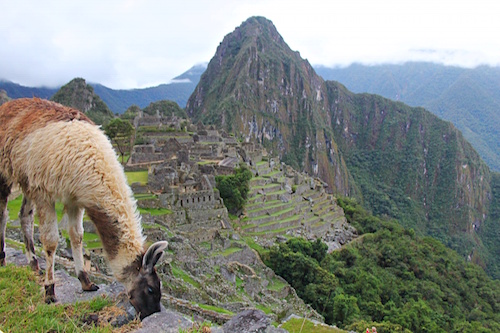
Travel. Workout. Write

In my first year teaching English in Prague in 2012, I taught a lot of lessons about travel (surprise!). I had one article about how …

Last week I left Santa Marta (in northern Colombia) in order to complete a four-day trek through the Sierra Nevada to the Lost City (Ciudad Perdida in Spanish). The fun part of the trek (or the problem if you don’t like trekking), is that the city is located 23 kilometers in the thick of the jungle (around 46 kilometers walking round trip). At first, I wasn’t sure how I felt about doing the trek since the Colombian government requires all trekkers to go with a guide and a group (some people got kidnapped back in 2003, you can watch the documentary on Banged Up Abroad). Typically, I don’t enjoy group treks because I want to go at my own pace. However, the tour ended up being really fun and I really loved my group.
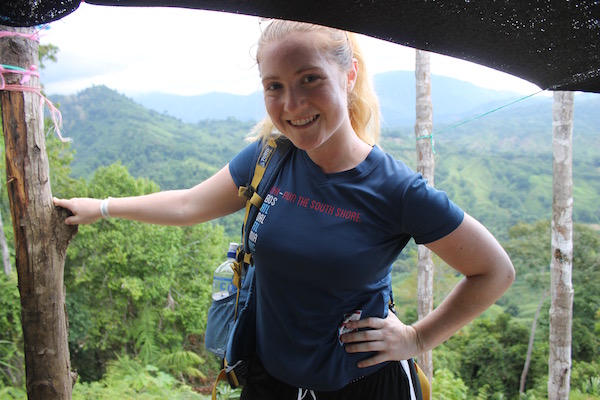
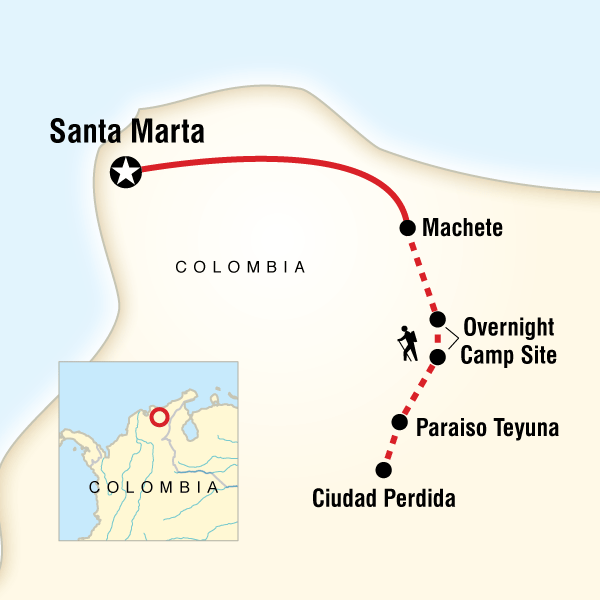
Physical Ability and Rough Terrain
I mentioned in my last post that I’ve been working out a lot and so I wasn’t too worried about the trek. Plus, I figured it couldn’t be more arduous than Everest Base Camp which I completed last September. The altitude is not high, and some girls I met told me the worst parts are just the humidity, the rain, and the mosquitos. They told me to prepare to be wet constantly. I packed a lot of extra clothes in plastic bags.
In my opinion, the trek was a perfect level of what I wanted. It wasn’t so hard that I got left behind, nor was it so easy I was bored. It felt adventurous, despite there being so many people on the trail. And because I could go at my own pace, I really pushed myself. I’m extremely competitive, so I ignored the first piece of advice given by our guide: “It’s not a race, don’t feel you have to rush.” I typically tried to see how fast I could push myself and how many other trekkers from other groups I could pass.

There were a few difficult parts going straight up which just involved cardiovascular determination and honestly weren’t as hard as the parts going straight down and covered with mud (el barro). I definitely slipped and fell on my butt the first day. My pinkie finger is still having difficulty bending, hurts if I apply pressure, and the knuckle is still swollen. A medical student said he didn’t think it was broken but I’m getting suspicious.
One of my favorite parts of the trek was the area near our camp the second night. Since we literally just turned around after the Lost City, I got to do this part twice. It was lots of little hills in the forest, a river crossing, and a narrow path along the river where, at one point, I literally had to climb up a vertical rock with my hands and knees. Crossing the river, I decided to leave my shoes on (they were already wet from the rain and I figured it would be easier than balancing on sharp rocks barefoot against a strong current).
On the way back, we found this little sketchy metal box with a rope to cross the river. You jumped in the box, and someone on the other side pulled you across. Super fun!

My shoes were constantly wet and by the last day I was a little worried I was going to get trench foot again or that the soles were going to peel off the shoes completely and I wouldn’t be able to walk. Luckily, neither happened, though my feet were very saturated and my shoes did this by the last day:

The Lost City
(*Please note that most of this information I received in Spanish from my guide so it may be incorrect. I tried to double check but Google has very little information on the subject)
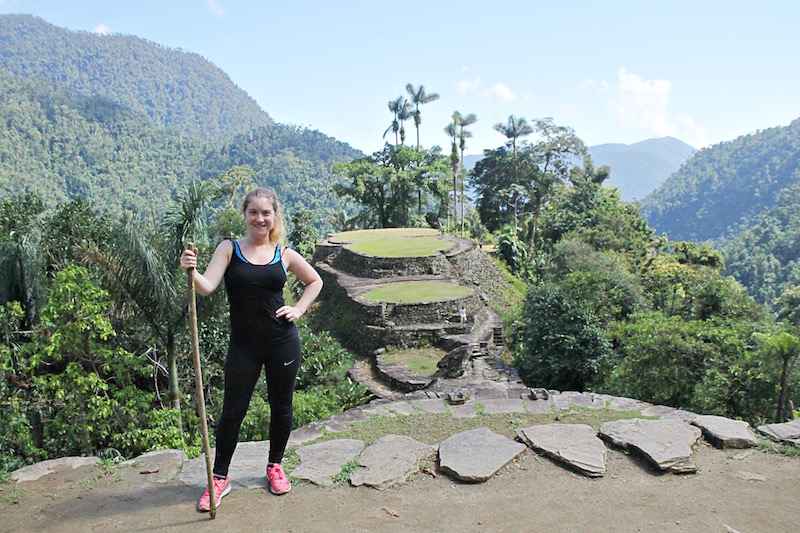
It is believed that the city was built around the year 800 CE, centuries before Machu Picchu. Archaeologists have found housing foundations over burial sites. People of importance were buried in the city in the fetal position with a rope tied around their waist in order to signify the return to the earth from which we are born.
In order to reach the city, we woke up at 5am, had breakfast, and started trekking. After about 30 minutes, we had to cross the deepest river of the trek. The water came past my waist and the current was very strong. Two guides had a rope to help people walk. I simply traversed the river in my shoes and clothes. However, I will never forget standing on the banks watching semi-nude people clinging to their clothes and shoes and the rope in their undies.
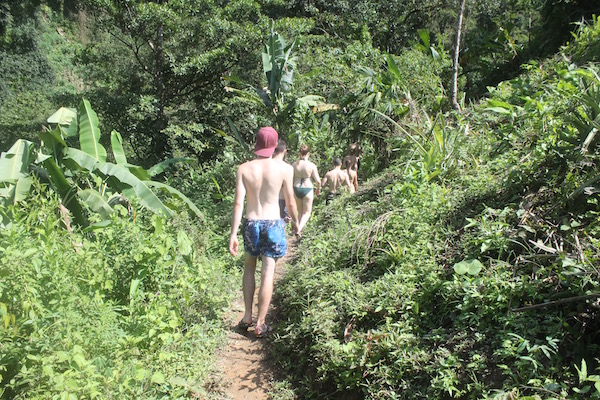
You then need to walk straight up 1,200 stone steps, worn from the passage of time into slick and small bumps.
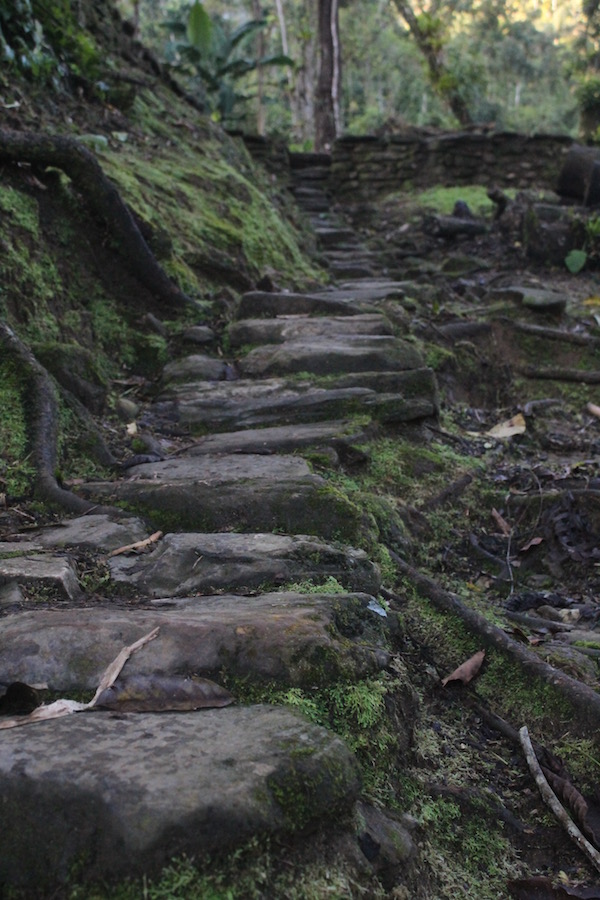
The site was abandoned during the Spanish “discovery” of South America. The natives traded their gold religious items with the Spanish conquistadors. Shortly after, disease began wiping the people out, as happened everywhere in “the new world.” Exposed to new bacteria and viruses, such a small pox, the natives had no immune defense. I believe our guide said 80% of the natives were killed.
Convinced that the Gods were punishing them for giving away their gold relics, the survivors abandoned the site and fled higher into the mountains. It is believed these natives are the ancestors of some of the remaining indigenous tribes in the Sierra Nevada, some of whom claim they had been visiting the site long before its rediscovery by local treasure hunters in 1972. Four indigenous tribes still live in the region. I wanted to write about them but this post is already double-length so I’ll simply provide a link for you to read about the Kogi people and the Arhuaco people.

Sleeping in Nature
Every night we went to bed around 8pm and woke up at 5am. I was under the impression I would be sleeping in hammocks every night but we actually got beds! The bunk beds had mosquito netting around them which seemed to do the job. However, that just left the mosquitos hungry for the morning.
The very first night there was a tarantula on the mosquito netting. (Spider: araña). I’m not sure I have ever seen a spider this big. I didn’t take a photo due to the lighting, but it was pretty impressive. Luckily, thanks to my mom, I’m not very afraid of spiders, though I didn’t really want to touch it and find out if it could bite. The guide brushed it off my bed and onto the floor.
That night I had trouble getting to sleep, not because of the sounds of nature coming from the river, but because my bed faced the TV that the family running the camp had set up. They were watching Titanic in Spanish. First, I watched some of it with them, but then I wanted to sleep. It’s really hard sleeping with people dying and screaming. Honestly, rewatch Titanic. People are screaming for ages. They take so long to finally die.
The morning of the third day, while we were packing our bags before going to the Lost City, I checked under my bed to make sure I didn’t leave anything and there were two hens under my bed! They were just hanging out down there. I told the Spanish people “pollo” and they laughed and taught me the Spanish word for hen (gallina). I told the Austrians and apparently one of them had an egg in his bed.
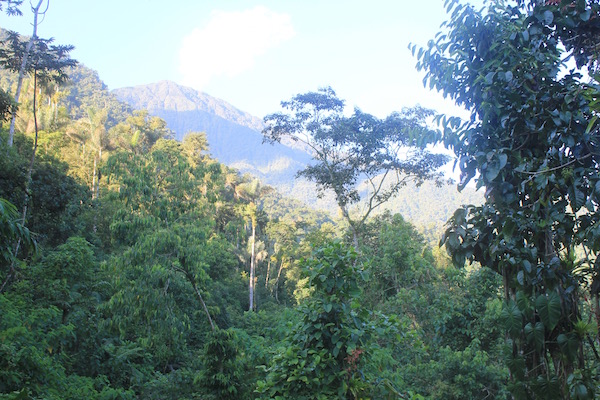
The Trek
I highly recommend doing this trek if you are in Colombia. It’s a great adventure and I learned a bit about the indigenous cultures and Colombian history. Plus, since the entire thing was in Spanish, I got to practice my listening skills a bit.
At the end of the trek, back at the restaurant where we started, one of the French trekkers asked us all what our favorite part of the trek was.
Mine probably wasn’t seeing the Lost City, but rather the end of the third day. It was one of the longest days, and I had pushed myself extra hard. My feet were raw from trekking in wet shoes, I was exhausted, and I finished half an hour before most of the group. The Austrian guy and I walked down to a river we had passed. Honestly, intense exercise is a bit like a drug. I relished in my endorphin rushes at the end of every day. I got in the cold water in my leggings and sports bra and laid on a rock in the river under this tree and watched the rain fall off the leaves and felt 100% relaxed in that moment. I know it’s really cheesy, but it’s own of those moments etched into my brain and labeled: “Pure happiness.”
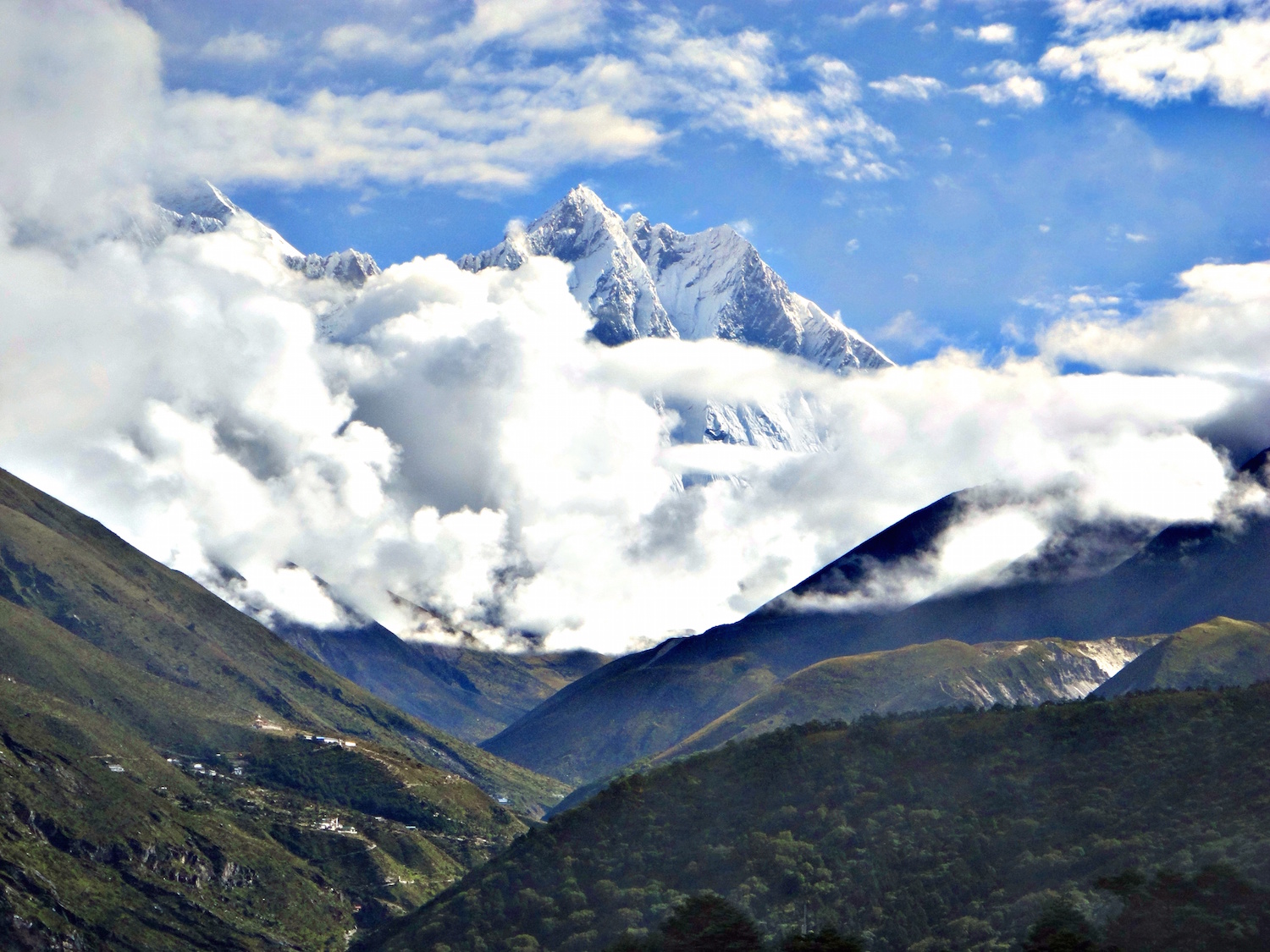
My experience trekking to Everest Base Camp not including the last 24 hours. There are no pictures of my trench foot included, so don’t be afraid to look at the photos 😀

(Read about me developing trench foot and getting trench foot in “24 hours to escape Everest Pt. I”)

Only 24 hours ago from writing this, I was sitting on the side of a road sobbing uncontrollably, unable to put any pressure on my foot as the top layers of skin had ripped away, leaving only raw, sensitive flesh that felt like razor blades every time I took a small baby step. The closest drivable town named Salleri still remained 2 whole hours away. This is where a jeep of my friends was waiting for me so we could leave the God-forsaken mountain trek and return to Kathmandu. I had put myself through hell for that jeep and 2 hours from the finish line I was left immobile. In 48 hours I had walked for 15 hours and around 50km up jagged rocks, through thick mud, over landslides, straight up for 4 hours, straight down for 2 hours, up a waterfall, through a river, exposed to leeches… I had done it all. For 4 days every action I took had been in order to leave the Everest region and return to Kathmandu as quickly as possible. Mentally, I was over it. I wanted to go home. I had waited 3 days for a plane that never came. I had agreed to pay for a helicopter but the weather was too bad for it to fly. I was feeling jittery and ready to get back to India to enjoy the few days remaining on my new tourist visa before my flight to the US. So jittery, I actually agreed to redo the most taxing and difficult part of the entire trek in half my original time. And it seemed like, just as I was almost there, just as I could almost taste the freedom, everything was caving in on itself.
Unfortunately, my foot would prove to be only one of many problems that occurred in those 24 final hours.
Taking a moment to back up, I have just finished my trek to Everest Base Camp (yay!). Most people doing EBC (as I discussed in my last blog) fly from Kathmandu to a mountain town named Lukla to do a moderately difficult 12- to 14-day trek. However, for those of us that like to make life difficult for ourselves, you can also take a jeep to Salleri, a town 55 km (34 miles) away from Lukla. This adds an extra 4 grueling days and the path is significantly more rugged and demanding compared to the more popular route. I told everyone that would listen that this was the hardest part of the entire trek, and I was happy about being able to fly from Lukla back to Kathmandu instead. Even on the third day of white fog blanketing Lukla and preventing anyone from leaving, I was telling my new trekking buddies in foul language how horrible that trek was, how crazy they were to attempt it, and that I was never repeating it.
Ten minutes later my bags were packed and I was walking down the mountain with them. I had panicked. The weather looked bad for more than a week and I worried that I’d get stuck in Lukla forever. I desperately wanted to get back to India for the mere week I had on my new visa. My friend’s Nepali guide said if we worked hard we could do the whole trek in two days and then take an overnight jeep. It seemed like a sure thing. The flights didn’t. So I took off.
Our group consisted of 2 Nepali guides from different tour companies, their clients (1 Aussie guy I had met early on, 1 Chilean girl no one knew), an American guy I met near the beginning of the trek, and 1 solo, lazy chick (me). We were all pretty desperate and determined to get out for different reasons and I believed we would, no matter how terrible it was. You can only drive to Salleri, after that the path is too choppy for a vehicle. Let me stress this: the only reason I agreed to this trek was because it would only take two days and a private overnight car. Any extra time and I would have mortgaged a house in Lukla and just given up on leaving the country.
The first day was taxing, but we made it halfway. The second day was brutal. It consisted of a 4-hour steep uphill climb full of blue skies in which we could watch airplanes and helicopters happily busing relaxed tourists out of Lukla while we sweated and panted underneath them. We had made the wrong decision. The weather was beautiful. It taunted us. By the time we were only a few hours out, I was significantly behind my group due to a pain in my foot. I told them to go ahead though, I’d hobble down the mountain as fast as I could to the jeep waiting for us. The hard part is over, I thought. Now it’s a gentle downhill for only about 2 hours. No worries. I even joked with one of the guys about the two of them leaving me in Salleri since I was too slow and he said, “that would never happen, we’re in this together.”
So let’s return to 5:24pm September 19th: Gwen is sobbing uncontrollably trying to remove a wet sock but the pain of even that is so much she can’t take it.
It will get dark in an hour and I’m two hours out. How do we solve this problem? Two Nepali men walked by on the path and saw me bawling and stopped to see what was wrong. They made a moaning noise upon seeing my foot. One tried to touch it and it made me sob more. The overly saturated skin was falling off leaving raw flesh. Luckily one spoke English quite well, better than most of the locals I had met. I explained that I needed to get to Kathmandu and my friends and a jeep were waiting for me in Salleri. I told him I had no phone and no number to contact them. I asked if I could arrange a horse; they said they didn’t think it was possible but convinced me to stand up and start walking with them. One of them took my bag and the other gave me an extra walking stick.

They stopped other locals to inquire about a horse but it wasn’t a possibility. They suggested I stop at a house for the night but I explained again that the jeep was waiting for me and I had no way to tell my friends that I wasn’t coming. Maybe my friends would wait for me for hours or even cancel the jeep. What if they sent a rescue party? No. We needed to get to Salleri as fast as possible. Plus, selfishly, I desperately wanted to leave. I guess I was hobbling at an extra pathetic pace because then one of the guys turned to me and said, “Ok. We carry you.”
And that’s how two Nepali guys started carrying me down the mountain.
The taller one took my bag and my walking stick. The smaller one, no taller than me and probably around my weight, bent over and threw me on his back and took off down the mountain in flip flops. After about 5-6 minutes he would get tired and I would go back to hobbling.
I guess two Nepali guys carrying a beat up looking blonde down a mountain sparked some curiosity among the locals (there were no other trekkers in the area at this point in the day) because eventually another random Nepali guy joined our group of aid workers. Mostly only the small English teacher took me, but once the taller one gave it a try and, despite his appearance, he wasn’t as strong as the little English teacher.
At one point the English teacher, carrying me best as possible, came across a small flood on the road. Instead of just walking through the ankle-deep water, he decided to walk to the edge of the cliff, and in a moment of sheer terror, he jumped on a large rock on the edge with me on his back and then proceeded to hop from rock to rock. We were literally playing a piggy-back hop scotch game on a rocky ledge.
Anything to get to Kathmandu.
Yet another guy joined us, bringing our entourage number up to a whopping 4 Nepali locals and me, the sun-burnt, trench foot ridden, smelly trekker. The fourth to join our crew was a similarly short guy but it didn’t take long for us to realize he was the strongest of them all. He carried me for significantly further than the other two had at any point and would put me down for only a second before lifting me again and running across a swing bridge or up a river bank.
Dusk set. We stopped and asked a woman if we could borrow her motorcycles parked in front of her house but she said they didn’t work. More carrying. We stopped for tea and they ordered a jeep to be brought as far up the road as it could go. They said only 15 more minutes of carrying me. It was 7pm now and pitch black so they strapped a headlamp to me.
At first I felt a bit guilty for what these men were doing for me, but at some point I had a feeling they were enjoying it a bit. It seemed like they wanted to see who could carry me the longest and go the fastest and they would laugh and joke around. I heard one of them saying he wished he had a head strap to carry me the way porters carrying their 50 kilo loads through the mountains. At some point they experimented with innovation and slung a jacket under my butt to help support my weight without touching me anywhere inappropriate.
15 more minutes. I suspected my team arrived in Salleri at 5pm. I had mentioned to them that I may be an hour or so behind them so I hoped, knowing that I was injured, they were waiting patiently and weren’t too worried about me. I hoped they wouldn’t be angry at having to wait; I knew how desperate we all were to get to Kathmandu. More than anything I hoped they hadn’t assembled any sort of search party for me yet. As we finished our trek, I scrutinized every flashlight-holding passerby to determine if it was one of my friends or one of their guides.
And then finally we got to the beautiful jeep and drove to Salleri. And then we drove around Salleri looking for any foreigners in lodges. And then, when I didn’t see anyone familiar, the jeep driver called his jeep driver buddies and told me,
“Yeah, a jeep with some foreigners left an hour ago.”
But no. It couldn’t be my foreigners. I barely spoke with the Chilean girl so sure, maybe she left. But the two guys? We had been in it since the beginning. We’d talked about life and death and every juicy detail in between. They knew more about me than most of the Indian people I’ve been hanging out with for a year. They knew I wanted to be back in Kathmandu so badly that I had agreed to walk 48 hours in the worst trek I’ve ever done. And the one had even laughed at the idea of leaving me behind as if it was a ridiculous statement only 5 hours ago. He told me we were a crew now. We were in this together. And I had told him, “You guys leaving me in Salleri is the only thing I can think of right now that would bring me to tears” while chuckling at the absurdity of the hypothetical situation.
“Yeah, its your friends,” the English teacher said, “They are in the next district over.” He handed me a small cellphone that looked like it had been rejected from the year 1998.
“Hello?”
It was one of the guys.
“Where are you?”
He said something I couldn’t understand. I asked him to repeat. Again just gibberish. I asked a third time as politely as I could muster.
“We had to go,” he said.
Four words. We had to go. And then silence. He hung up. Just like that. So I was stranded in Salleri, alone, with a destroyed foot, 4 Nepali locals looking horrified at the situation, and a driver who wanted his 800 rupees ($8) for rescuing me. The English teacher told me to spend the night in a lodge and I could go to Kathmandu in the public jeep the next morning. But I was devastated. I felt totally dejected and abandoned. Betrayed. Friendless. Plus, I wanted time to see a doctor about my foot in Kathmandu and I wanted to get back to India.
So I told them I wanted to take the jeep to Kathmandu that night and we agreed on a price: 16,000 rupees for the 9-hour ride. $160. It was a lot. Cheaper than most tourists get a jeep for (the going price is $200), but they typically split the cost between multiple people. More expensive than my plane ticket from Lukla to Kathmandu. I can’t stress how upset I was in this moment. I hadn’t washed my hair in three weeks. My foot was swelling and tingling. The time on my India visa was dwindling. And at this moment in time I really hated Nepal and really wanted to leave. Plus, emotionally, I was wrecked. I had opened up and been kind of these people and felt as though, since I was the weakest link, I was too inconvenient to wait for.
So I agreed on the price and it was agreed that two of the Nepali guys would accompany me to Kathmandu for free (my way of saying thank you for their help). And we left.
I spent most of the car ride thinking about this kind of balance, about how these men who didn’t know me had gone out of their way to help and the people I felt closest with hadn’t. I thought a lot about the type of person I wanted to be and how Westerners are so much more selfish than the people I have met in India (and Nepal) when it comes to favors.
A lot of emotional stuff went through my head that night. Eventually I drifted off around midnight with the jeep bumping manically up and down the rocks of the jagged rock and dirt road from Salleri. But soon I would wake up at 4 am on the side of the road to an empty van….
I’ll post the second part of my 24 manic hours finishing my EBC tomorrow. Before you hate too hard on my friends, the pt. 2 involves a bit of redemption and a visit to the police station.

I was completely blown away with the response I got from my last blog. I’ve never had so many shares, comments, and views. In three days I had over 600 people from 25 different countries read my blog. Yes! This is the most exciting thing to happen to me in months. Seriously, I check my blog stats like a crazy person and get really excited when anyone comments. I then wondered how I would ever top that, especially since yesterday my Indian visa expired so I had to flee the country.
No, I’m not back in the US. Despite how much I complain about India (sorry, Indian friends), I’m not ready to leave. Since I can’t convert my employment visa to a tourist visa while still in India, I’m currently sitting in Kathmandu, Nepal! I’m going to apply for the 30-day e-tourist visa which usually takes about 4 days to process. I considered just waiting a few days while my tourist visa processes and returning to Chandigarh to write full time. But then I thought, “why not make it a memorable visa run?”
So I’m climbing Mount Everest.
Ok, so not for real. But sort of. More or less, I am “climbing around Mount Everest.” A friend jokingly quoted this to me a few months ago (its from a movie, I have no idea which one). But now, reflecting, that’s basically what I am doing. To actually climb Mountain Everest (to the summit) you need about $100,000 USD, months of acclimatizing, and years of experience. Let’s be honest, I don’t want to spend $100,000 that way (if I had it). Also, I’m just not that in shape and I’m 100% fine with not being in “Climbing Mt. Everest shape.” I also don’t love heights. And I hate cold. So I don’t think it’s right for me.
But I am trekking to Everest Base Camp, so technically I’ll be at the base of Everest, which is (5,380 meters or 17,6000 feet). I’m pretty excited about the trek, though also questioning my own sanity. I did a trek to 3,600 meters last summer and thought I was dying. I’m extremely sensitive to altitude. Honestly, it’s probably going to be horrible. I’m expecting to complain most of the way.
But like I said in my last post, I spend a lot of time obsessed with my own mortality and in a month I could be 6-feet-under from a freak disease (I’ve had one), a gun/terrorist attack (see last blog post), or, let’s be honest, just crossing a street in Delhi (that many cars should not be in one place at one time going that fast). So I should take the opportunity now. And I tend to enjoy these things even when I hate these things (like scuba diving). Plus, it looks absolutely stunning and I love the idea of actually getting to stand on Everest, even if just a little bit.
The best part of EBC is that there are tea houses (little lodges) all the way up since people actually live in the area, which means I don’t have to camp. It also means I don’t have to hire a porter or a guide. This sounds riskier than it actually is. I visited Nepal in April and everyone I spoke to told me the same thing: there is no point in hiring a guide, there are so many people on the trek that you won’t get lost. Also, my colleague from Jaipur, April, put me in touch with a guy she met traveling in Northern India from the Netherlands. We met up yesterday and are going to go together (for at least some of the trek). So I won’t even be alone as I originally thought.
Most people fly to Lukla from Kathmandu. Instead, we are waking up and leaving at 4:30am in order to take a shared van to Salleri and we will walk a few extra days than required in order to better acclimatize. I found an itinerary from a travel company and we basically decided to just follow what they do (except not pay them or have a guide and just rough it on our own). It looks a bit like this:
Day 1: Drive to Salleri (9-10 hours)
Day 2: Salleri to Taksindo (5-6 hours)
Day 3: Taksindo to Kharikhola (5-6 hours)
Day 4: Kharikhola to Paiya (5-6 hours)
Day 5: Paiya to Phakding (5-6 hours)
Day 6: Phakding to Namache Bazaar (5-6 hours)
Day 7: Acclimatization Day
Day 8: Namache Bazaar to Tengbuche, 3870m (5-6 hours)
Day 9: Tengbuche to Dingbuche, 4350m (5-6 hours)
Day 10: Dingbuche to Loboche, 4950m (4-5 hours)
Day 11: Loboche to Gorakshep and to Everest Base Camp, 5365m (8-9 hours)
Day 12: Kalapatthar, 5545m to Pheriche, 4200m (6-7 hours)
Day 13: Pheriche to Namache Bazaar (5-6 hours)
Day 14: Namache Bazaar to Lukla (5-6 hours)
Day 15: Fly from Lukla to Kathmandu
Day 16: Return to India
You can see the actually itinerary here. Also, I booked a flight back to Lukla for September 17th instead of September 15th just to work in a few extra rest days/exploration day. I think my trekking partner wants to spent more time in the mountains than I do, so at some point we may split off. Let’s see.
People are living in all of these places, except for Everest Base Camp. But even there, the Everest mountaineers are essentially living there for a few months as they slowly ascend and descend Everest in order to get used to the altitude. Altitude is the biggest danger. I even bought travel insurance (which I NEVER do) just because one blog I read said that they saw 12 people airlifted off the mountain in 15 days from altitude sickness. Essentially, I paid $90 so that if this happens I won’t owe $25,000 to the Nepalese rescue services. Also, I read that the next biggest danger is yaks. People have been herded off the mountain by yaks passing on narrow paths. That sounds absolutely terrifying so I’ll try not to die by yak or altitude. Both sound like pretty obnoxiously strange and preventable ways to go out.
So, how does one prepare for trekking to EBC?
I spent a large chunk of the day buying supplies from a nice lady who gave us pretty decent discounts on everything in the store. I’m going to put the costs of everything for the trip so people can get a good sense of how much a trip would cost:
Kathmandu:
Hotel stay in Kathmandu for 2 nights: 800 rupees ($7.50)
Taxi from the airport: 1000 rupees ($9.30)
3 (nice) meals in Kathmandu: 1400 ($13)
Supplies:
Trekking Boots: 3800 rupees ($35.45)
Sleeping Bag rental: 65 rupees/day + 2000 rupee deposit ($18.65, which I will get back)
Coat +rain jacket with hood: 2500 rupees ($23)
Socks: 150 rupees ($1.40)
Sunglasses: 250 rupees ($2.33)
2 boxes of water purifying tablets (50 tablets/box): 400 rupees ($3.73)
Snacks (including medicinal lip ointment): 1900 rupees ($17.72)
Walking sticks: 750 rupees ($7)
Transportation:
Jeep from Kathmandu to Salleri: 2500 rupees ($23.32)
Permit: 3390 rupees ($31.62)
Total so far: 20,840 rupees ($194)



Then we will be paying for places to stay, food, charging our phones, showers, etc… I’m planning to bring about 50,000 rupees with me (though I’ve read that people get by with much less). Since I’m not sure I will have internet for the next 12-20 days, keep a look out for my future stories which will (hopefully) be entertaining and not disastrous.
*Featured Photo from Kasol, India. It is NOT of Everest. But I’ll have plenty of those soon 😀